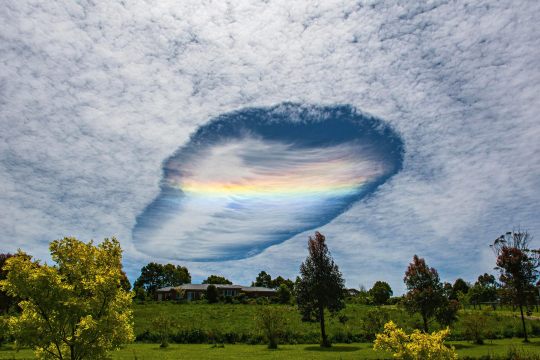#fallstreak hole
Text

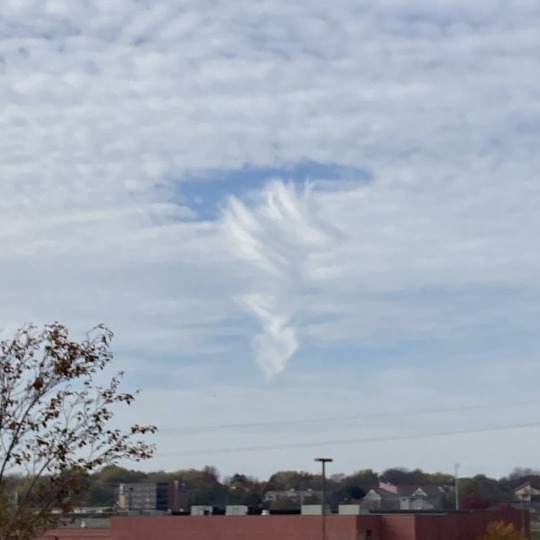
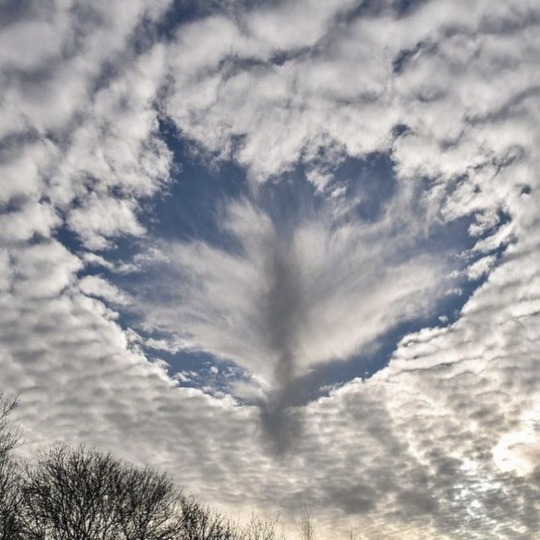

A fallstreak hole is a large gap, usually circular or elliptical, that can appear in cirrocumulus or altocumulus clouds. The holes are caused by supercooled water in the clouds suddenly evaporating or freezing, and may be triggered by passing aircraft.
3K notes
·
View notes
Text
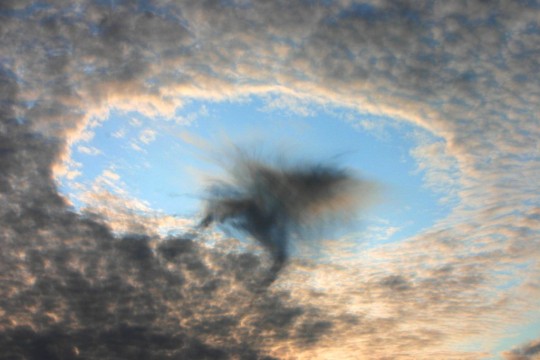
Hole Punch Cloud or Fallstreak Hole
August 17, 2008
1 note
·
View note
Text
Cool and unusual weather/natural phenomenon to include in your fantasy novel:
Ball lightning
Sun dogs and sun pillars
Lenticular clouds
Aroura Borealis/Aroura Australis
Fallstreak holes
Eclipses, solar and lunar
Cryoseisms (frost quakes)
Frost flowers
Thundersnow
Sprites
Crown flashes
755 notes
·
View notes
Text
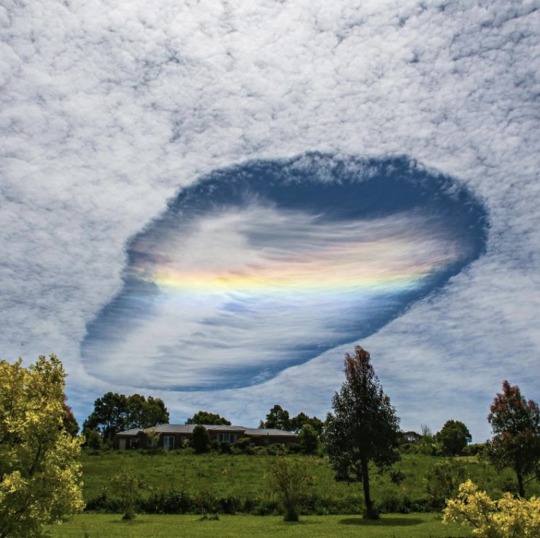



Fallstreak Clouds spotted in Ocala, Florida
This unusual cloud phenomenon is called a fallstreak cloud. A fallstreak (also known as a hole punch cloud, skypunch, or cloud canal) is a large gap, that can appear in cirrocumulus or altocumulus clouds. The holes are caused by supercooled water in the clouds suddenly evaporating or freezing, and may be triggered by passing aircraft.
#fallstreak clouds#phenomenon#nature#sky#landscape#rainbow#naturecore#sciencecore#science#skycore#rainbowcore#mother nature#cloudcore#clouds
69 notes
·
View notes
Text

A fallstreak hole is a rare and spectacular weather phenomenon. The inhabitants of the state of Victoria (in the south-east of Australia) had the chance to observe one a few days ago. A fallstreak hole forms an oval or circular cutout in the layers of a cloud like cirrocumulus or altocumulus. Weather specialists believe that at some point part of the cirrocumulus or altocumulus cools. The water droplets in the cloud then go to a negative temperature (below zero). Instead of freezing these droplets remain liquid. (Physicists call this phenomenon, supercooling).
As they grow, these crystals gain in size and weight. At a certain stage, these frozen droplets are much heavier than the other droplets that surround them. They then fall below the cloud layer, evaporate quickly and leave a hole behind.
The superb rainbow that can be observed in the Gippsland formation is naturally the result of a refraction of the white light emitted by the Sun through the ice crystals persisting in the middle of the opening. When the light rays cross these frozen goulettes, the colors come out separated.
22 notes
·
View notes
Note
weather for me for triniet ? + @qjaiden
OF COURSE!!!! Fallstreak hole!

3 notes
·
View notes
Photo

A Fallstreak Hole over Coquitlam, BC, Canada [OC] [1600x1200]
6 notes
·
View notes
Text
i like cool clouds and i think we dont talk about them enough
there are like, a LOT of really weird clouds that i genuinely wouldn't know how to show them off in any coherent order besides putting Clouds I Like.
these are Kelvin-Helmholtz clouds (also known as the Kelvin-Helmholtz wave). "They occur when there is a strong vertical shear between two air streams, causing winds to blow faster at the upper level than at the lower levels."
theyre just really cool looking :).


these are double helix clouds and they're VERY rare, and kinda hard to explain without citing a source. "they're a form of Kelvin-Helmholtz instability and the structure is called (aptly enough) a braid."
despite being rare, the few that have existed have been documented and researched, starting in 2012.
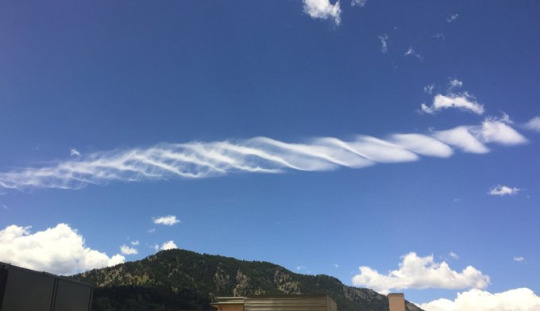

mammatus clouds are formed because of cold air sinking down to form the pockets contrary to the puffs of clouds rising through the convection of warm air. it kinda reminds me of when you put oil in a cup of water. there are a couple of different kind of mammatus clouds, but they usually result in a similar visual outcome.


asperitas clouds name translates to "roughness" and it was first documented in 2009, being included to the cloud atlas in 2017! "Like mentioned in a previous article on Kelvin-Helmholtz Instability, atmospheric and fluid dynamics play a role in the origins of these clouds. Shifting wind directions and velocities appear to cause Asperitas’ wave-like structure, much like how velocity and current direction influences a fluid. Winds shifting in the horizontal and vertical direction is thought to help create the structure of these clouds.."
i personally like to call them asparagus clouds because i dont know how to pronounce asperitas and i think asparagus clouds is a way better name.


arcus clouds
there are two types, both listed below. an arcus cloud is a low, horizontal cloud formation, usually appearing as an accessory cloud to a cumulonimbus (a storm cloud). the first pair of images is a shelf cloud.
" they're formed by the rising cloud motion which can often be seen in the leading (outer) part of the shelf cloud, while the underside can often appear as turbulent and wind-torn. Cool, sinking air from a storm cloud's downdraft spreads out across the land surface, with the leading edge called a gust front. This outflow cuts under warm air being drawn into the storm's updraft."


the second pair are morning glory clouds, which is a rare meteorological phenomenon that can happen to certain roll clouds. they're most common (and easy to predict) in Australia. "One of the main contributors for the formation of the morning glory clouds is the mesoscale circulations associated with a difference in sea breezes that develop over the Peninsula and the Gulf."
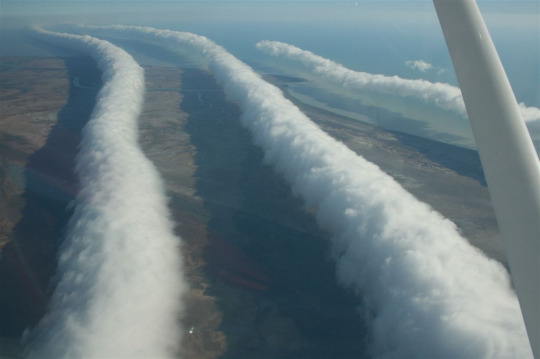

lenticular clouds are cool to me because it's very likely that a majority of UFO sighting ARE THESE BABIES RIGHT HERE!! something about that is really cool to me, and i've also included some photos of the clouds at night so you can see the confusion. "they form because as air travels along the surface of the Earth, obstructions are often encountered, including natural features, such as mountains or hills, and artificial structures, such as buildings and other constructions, which disrupt the flow of air into "eddies", or areas of turbulence.
When moist, stable air flows over a larger eddy, such as those caused by mountains, a series of large-scale standing wave forms on the leeward side of the mountain. If the temperature at the crest of the wave drops below the dew point, moisture in the air may condense to form lenticular clouds."


these two arent inherently clouds, and more so have to do WITH clouds.
"fallstreak holes are a large gap, usually circular or elliptical, that can appear in cirrocumulus or altocumulus clouds. The holes are caused by supercooled water in the clouds suddenly evaporating, and may be triggered by passing aircraft."
they're SO cool looking, and i like the way they can be caused by aircrafts, meaning its influenced by humans. thats the part of nature i find cool, is the way we interact with our ecosystem and biosphere.

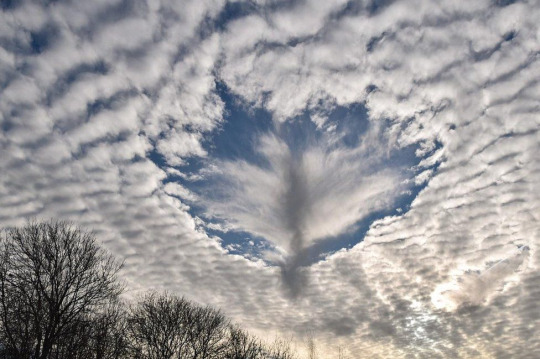
on the side of rainbows, this is a form cloud iridescence that happened in china. "Cloud iridescence or irisation is a colorful optical phenomenon that occurs in a cloud and appears in the general proximity of the Sun or Moon. The colors resemble those seen in soap bubbles and oil on a water surface. It is a type of photometer. This fairly common phenomenon is most often observed in altocumulus, cirrocumulus, lenticular, and cirrus clouds."
theyre just really cool and i like gay clouds
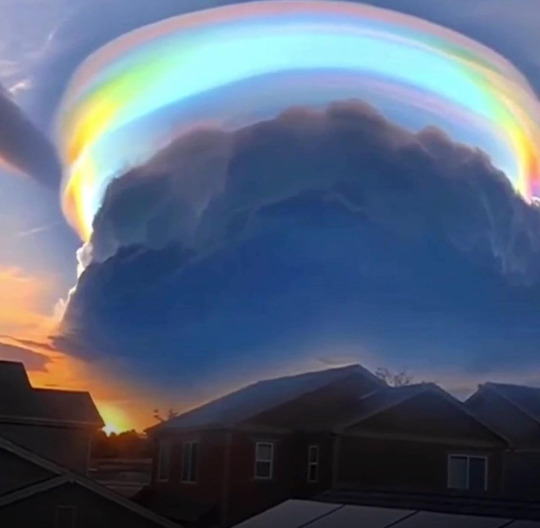

these two kind of parallel each other, but also, they kinda Do Not. i love them both either way.
"Noctilucent clouds are tenuous cloud-like phenomena in the upper atmosphere of Earth. They consist of ice crystals and from the ground are only visible during astronomical twilight."


but from space?
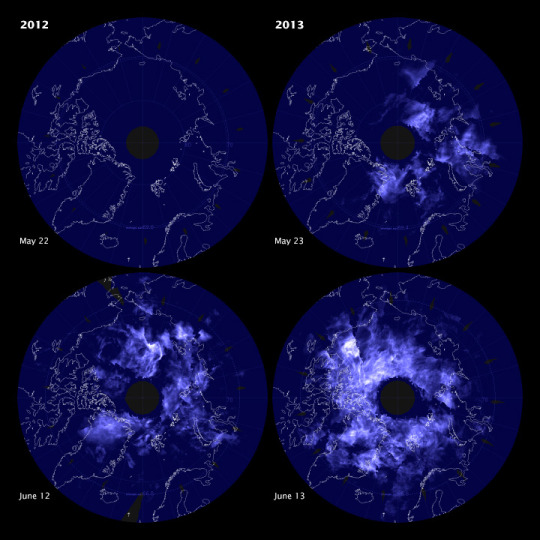
THATS so cool to me. you can see that fucker from space!!
the aurora borealis on the other hand is something i find very cool, but very VERY terrifying. "they're the polar lights and are a natural light display in Earth's sky, predominantly seen in high-latitude regions (around the Arctic and Antarctic)."

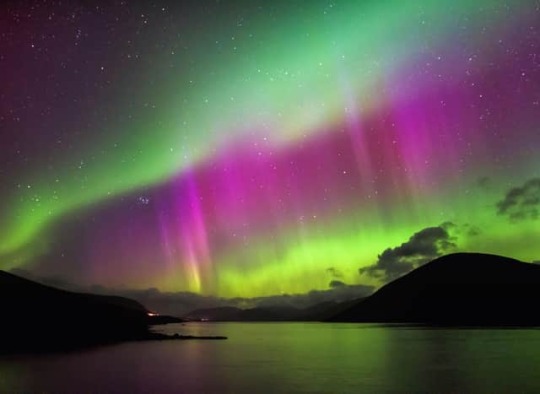
the part that terrifies me is this: "Auroras are the result of disturbances in the magnetosphere caused by the solar wind. Major disturbances result from enhancements in the speed of the solar wind from coronal holes and coronal mass ejections. These disturbances alter the trajectories of charged particles in the magnetospheric plasma. These particles, mainly electrons and protons, precipitate into the upper atmosphere (thermosphere/exosphere). The resulting ionization and excitation of atmospheric constituents emit light of varying colour and complexity. The form of the aurora, occurring within bands around both polar regions, is also dependent on the amount of acceleration imparted to the precipitating particles."
like....yeah. yikes. beautiful but damaging and terrifying :)
oh yeah heres that baby from space by the way!!
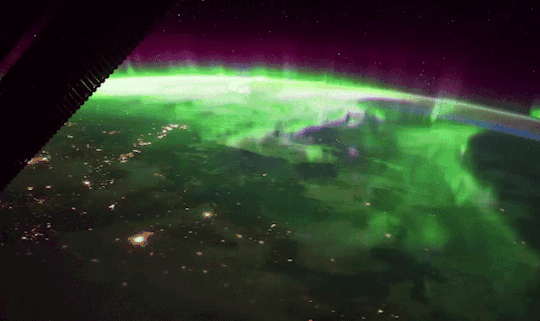
11 notes
·
View notes
Text
UNUSUAL MUSE ASSOCIATIONS.

spice: ginger.
weather: clouded summer evening with a nice breeze.
color: white, gold.
sky: fallstreak hole.
shoe: leather boots.
houseplant: tiger thorn plum.
weapon: guan dao.
subject: history, literature.
social media: if any at all ... linkedin ):
makeup product: brush.
candy: dark chocolate. dried fruit.
fear: lack of agency.
ice cube shape: round.
method of long-distance travel: starskiff.
art style: scenic. heavenly style.
historical period: 18th century.
mythological creature: pixiu.
piece of stationery: fountain pen.
three emoji combination: 😌🍂🍵
celestial body: bubble galaxy.
tagged by: took it from my other blog.
tagging: whoever feels up for the challenge!
1 note
·
View note
Text
NASA Spots Circular Cloud Holes Over Florida, Sparking Curiosity (Not UFO Mania)
NASA’s Terra satellite recently captured an image of the sky above the Gulf of Mexico, just off the coast of Florida, revealing several intriguing circular gaps in the clouds. These unusual formations, known as “cavum clouds,” “fallstreak holes,” or “hole-punch clouds,” have captured attention not only for their appearance but also for their occasional link to reported UFO sightings.
However,…
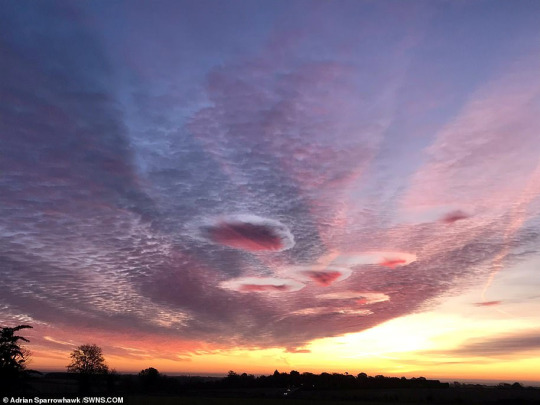
View On WordPress
1 note
·
View note
Text
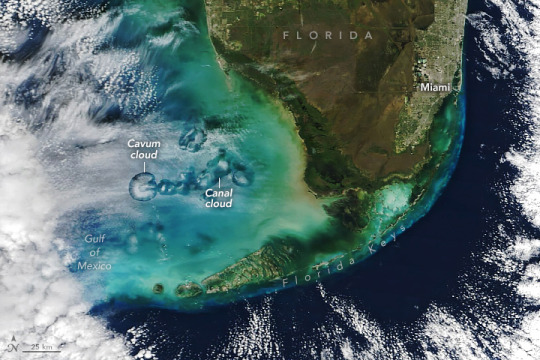
Making Sense of Holes in the Clouds
Cavum clouds, also called hole-punch clouds and fallstreak holes, look so odd that people sometimes argue they are signatures of flying saucers or other unidentified anomalous phenomena. Seen from below, they can look like a large circle or ellipse has been cut neatly from the clouds, with feathery wisps left in the middle of the hole.
They are equally impressive when seen from above. This image shows a cluster of cavum over the Gulf of Mexico off of Florida’s west coast on January 30, 2024. It was captured by the MODIS (Moderate Resolution Imaging Spectroradiometer) on NASA’s Terra satellite.
Otherworldly explanations are not required to explain the eye-catching cloud formation. While scientists have periodically mentioned the phenomena in scientific journals and speculated about their cause since the 1940s, a pair of studies published in 2010 and 2011, led by University Corporation for Atmospheric Research (UCAR) scientists, laid out an explanation that put other theories to rest. They are caused by airplanes moving through banks of altocumulus clouds.
These mid-level clouds are composed of liquid water droplets that are supercooled; that is, the droplets remain liquid even when temperatures are below the typical freezing point of water (32 degrees Fahrenheit, or 0 degrees Celsius). Supercooling happens when water droplets are exceptionally pure and lack small particles, such as dust, fungal spores, pollen, or bacteria, around which ice crystals typically form.
Supercooling may sound exotic, but it occurs routinely in Earth’s atmosphere. Altocumulus clouds, which cover about 8 percent of Earth’s surface at any given time, are mostly composed of liquid water droplets supercooled to a temperature of about -15°C.
But even supercooled clouds have their limits. As air moves around the wings and past the propellers of airplanes, a process known as adiabatic expansion cools the water by an additional 20°C or more and can push liquid water droplets to the point of freezing without the help of airborne particles. Ice crystals beget more ice crystals as the liquid droplets continue to freeze. The ice crystals eventually grow heavy enough that they begin to fall out of the sky, leaving a void in the cloud layer. The falling ice crystals are often visible in the center of the holes as wispy trails of precipitation that never reach the ground—features called virga.
Unlike previous attempts to explain the phenomena, the UCAR researchers, with colleagues from several other institutions, including NASA’s Langley Research Center, made use of a combination of aircraft flight data, satellite observations, and weather models to explain how the clouds form and to track how long they lasted. When planes passed through clouds at a fairly sharp angle, the researchers found that small, circular cavum appeared. If they passed through the clouds at a shallow angle, longer “canal clouds” with lengthy virga trails, like the one shown above, became visible.
Other factors that can affect the length of these clouds include the thickness of the cloud layer, the air temperature, and the degree of horizontal wind shear, the researchers reported. Their analysis showed that a full spectrum of aircraft types including large passenger jets, regional jets, private jets, military jets, and turboprops can produce cavum and canal clouds. With more than 1,000 flights arriving at Miami International Airport each day, there are many opportunities for planes to encounter the atmospheric conditions needed to produce cavum clouds.
NASA Earth Observatory image by Michala Garrison, using MODIS data from NASA EOSDIS LANCE and GIBS/Worldview. Story by Adam Voiland.
1 note
·
View note
Text
Dare un senso ai buchi nelle nuvole
Le nubi cavum, chiamate anche “hole-punch clouds” e “fallstreak holes”, hanno un aspetto così strano che a volte si sostiene che siano la firma di dischi volanti o di altri fenomeni anomali non identificati. Viste dal basso, possono sembrare un grande cerchio o un’ellisse tagliata di netto dalle nuvole, con ciuffi piumosi lasciati al centro del buco.
Sono altrettanto impressionanti se visti…
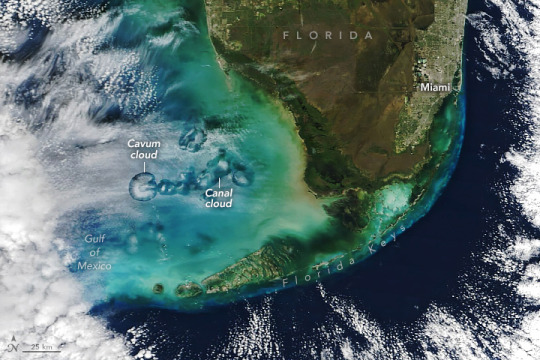
View On WordPress
0 notes
Text
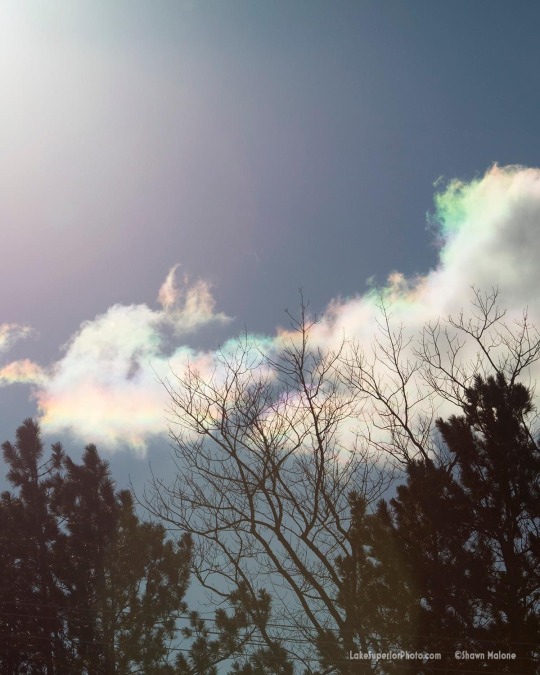



[Lake Superior Photo - Gallery/Studio]
Arctic air brought in some amazing iridescent clouds today!⛅️
1.30.23 • Facebook
you see, we don’t really belong to this world.
and at some point we’re going to take off from this place to go “Home”
even to reach the point of (A secret elopement) and the [metamorphosis] of meeting the Lord and eternal King in the clouds of the air
(to forever be Together)
and the Spirit is here as a guarantee of this (as an engagement ring abiding within the sacred space of the heart)
there is a heavenly “marriage” to come (the marriage of the Lamb) and we also see our Creator’s design of earthly marriage as a lifelong covenant of unbroken trust shared between a man & a woman who literally become as “One” body

@RShoptaugh
Take a look! These are fallstreak holes or “hole punch clouds” spotted in South Texas today. Typically, as planes pass through high to mid-level clouds, supercooled water droplets freeze, grow and fall quickly. A hole is left behind as more droplets freeze and fall! #txwx
1.26.23 • 2:30pm • Twitter
1 note
·
View note
Text
Hole-Punch Clouds (Fallstreak Hole)
You might not find the once rare, hole-punch cloud (fallstreak hole) among the “new clouds” listed in the revised International Cloud Atlas.
Not surprisingly the number of “new clouds” being generated by geoengineering is the same as the number of chemical mixtures used for aerosol distribution in chemtrails.
What are Hole-Punch clouds?
Hole-punch clouds point to an atmospheric release of…
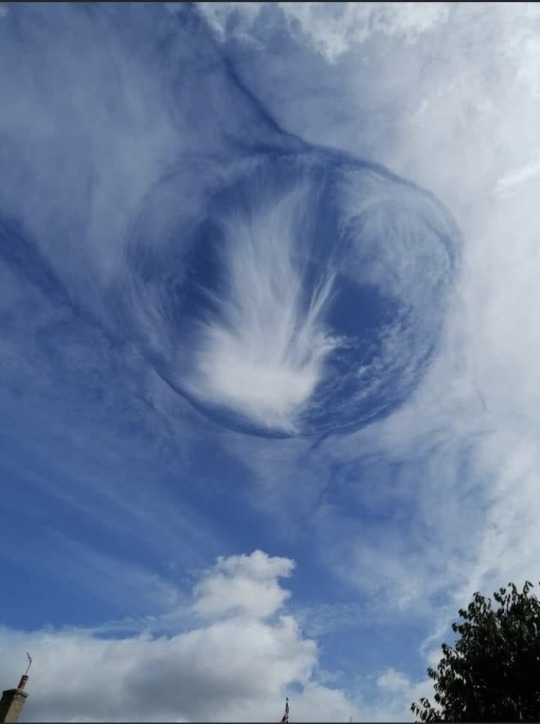
View On WordPress
0 notes
